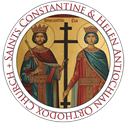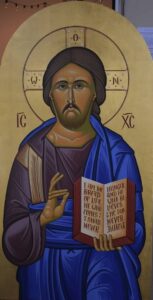Please join us for Divine Liturgy and upcoming events at Saints Constantine and Helen Church!

Church Calendar & Upcoming Events
Pan-Orthodox Vespers at St. Seraphim Orthodox Cathedral
St. Seraphim Orthodox Cathedral 4208 Wycliff Avenue, Dallas, TX, United StatesGreat Compline
Sts. Constantine and Helen 1225 E Rosemeade Pkwy, Carrollton, TX, United StatesPresanctified Divine Liturgy followed by Potluck Dinner
Sts. Constantine and Helen 1225 E Rosemeade Pkwy, Carrollton, TX, United StatesLittle Compline with the Canon of the Raising of Lazarus
Sts. Constantine and Helen 1225 E Rosemeade Pkwy, Carrollton, TX, United StatesMatins (Orthros)
Sts. Constantine and Helen 1225 E Rosemeade Pkwy, Carrollton, TX, United StatesFor the Feast of the Raising of Lazarus
Divine Liturgy of St. John Chrysostom
Sts. Constantine and Helen 1225 E Rosemeade Pkwy, Carrollton, TX, United StatesFor the Feast of the Raising of Lazarus
Great Vespers
Sts. Constantine and Helen 1225 E Rosemeade Pkwy, Carrollton, TX, United StatesMatins (Orthros)
Sts. Constantine and Helen 1225 E Rosemeade Pkwy, Carrollton, TX, United StatesFor Palm Sunday
Divine Liturgy of St. John Chrysostom
Sts. Constantine and Helen 1225 E Rosemeade Pkwy, Carrollton, TX, United StatesBridegroom Orthros for Holy Monday
Sts. Constantine and Helen 1225 E Rosemeade Pkwy, Carrollton, TX, United StatesIn commemoration of the Ten Virgins from the Holy Gospel of Matthew 25:1-13

Divine Liturgy
Divine Liturgy represents a communal response to and participation in the sacred through activity reflecting praise, thanksgiving, remembrance, supplication or repentance. The Eastern Orthodox church follows the Liturgy of Saint John Chrysostom which is the most celebrated divine liturgy in the Byzantine rite.
It is named after its core part, the anaphora attributed to Saint John Chrysostom, Archbishop of Constantinople in the 5th century. In Constantinople, it was refined and beautified under John’s guidance as Archbishop (398–404).
As a divine liturgy of the Church of Holy Wisdom, Hagia Sophia, it became over time the usual divine liturgy in the churches within the Byzantine Empire. Just two divine liturgies (aside from the presanctified), those of Saints John and Basil the Great, became the norm in the Byzantine Church by the end of the reign of Justinian I.
After the Quinsext Council and the liturgical reforms of Patriarch Theodore Balasamon, the Byzantine Rite became the only rite in the Eastern Orthodox Church, remaining so until the 19th and 20th Century re-introduction by certain jurisdictions of Western Rites.
The Divine Liturgy is the common action of Orthodox Christians officially gathered to constitute the Orthodox Church. It is the action of the Church assembled by God in order to be together in one community to worship, to pray, to sing, to hear God’s Word, to be instructed in God’s commandments, to offer itself with thanksgiving in Christ to God the Father, and to have the living experience of God’s eternal kingdom through communion with the same Christ Who is present in his people by the Holy Spirit.


